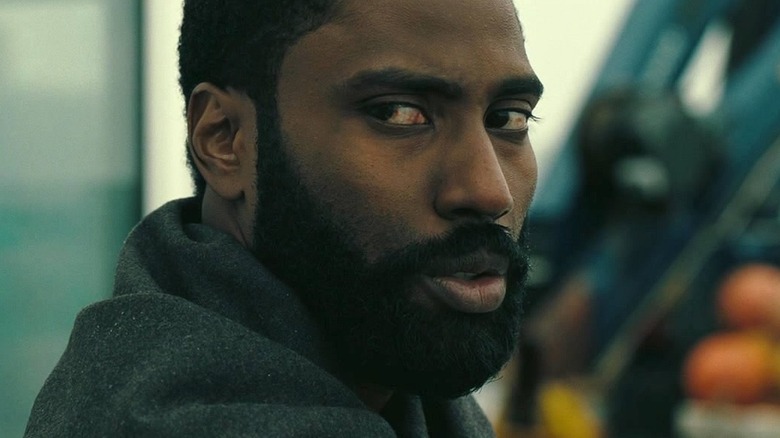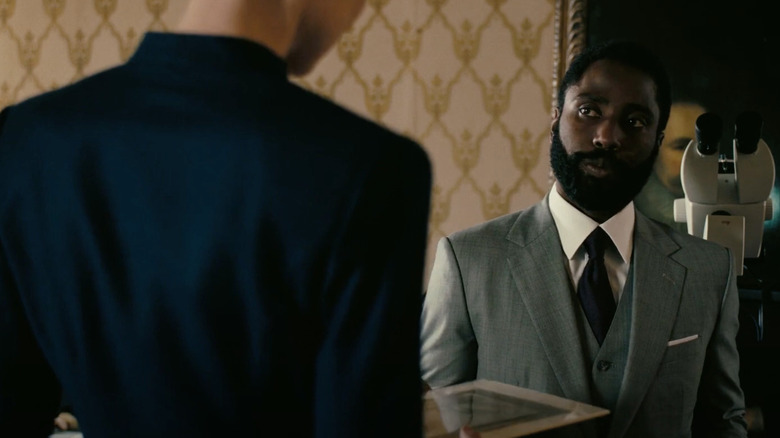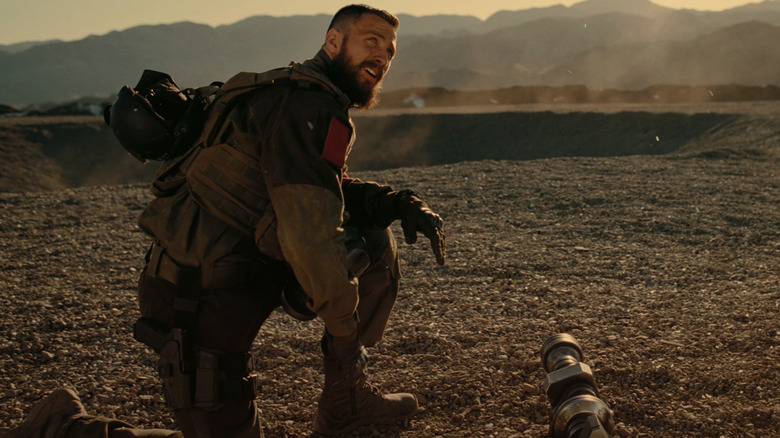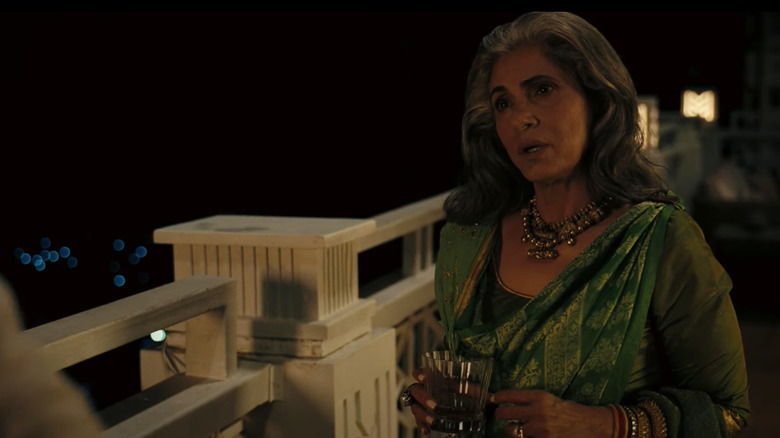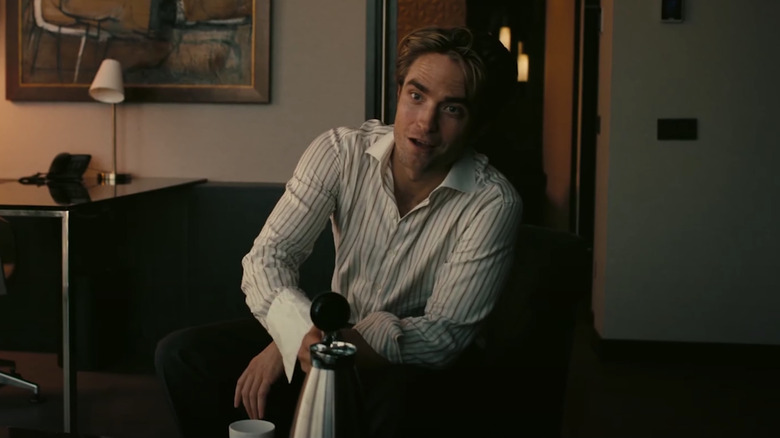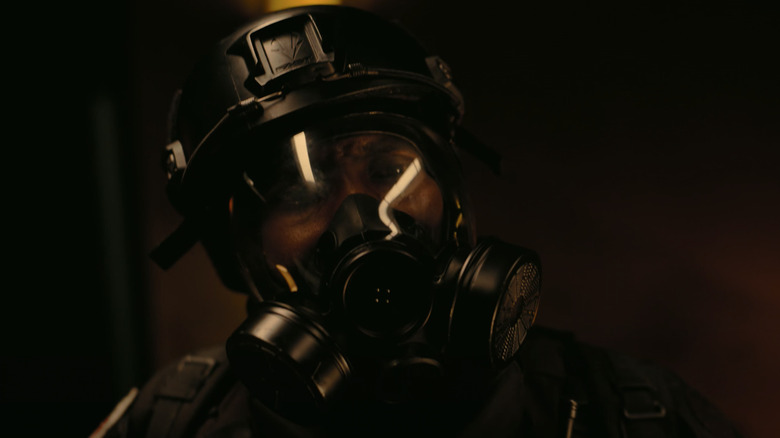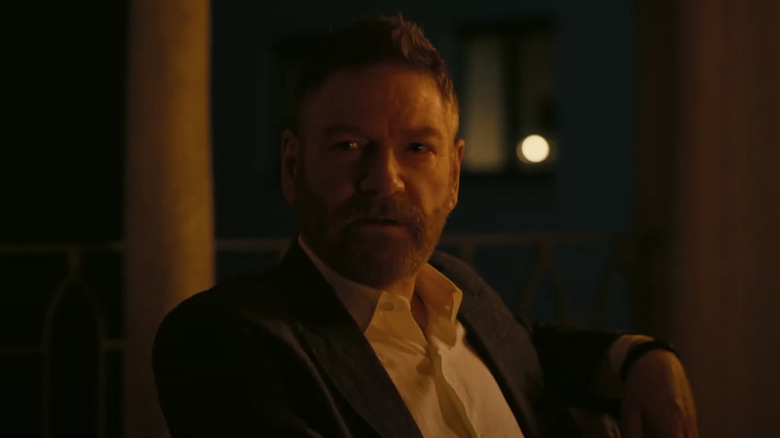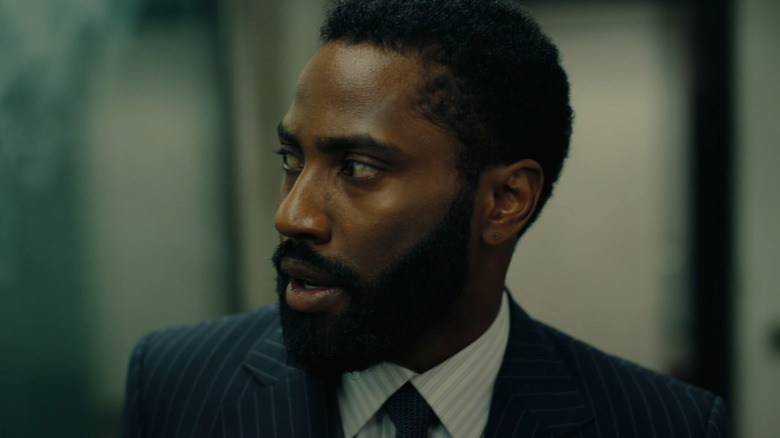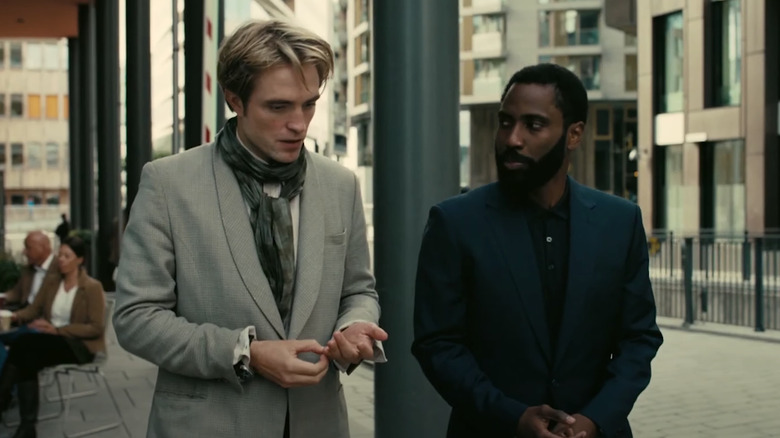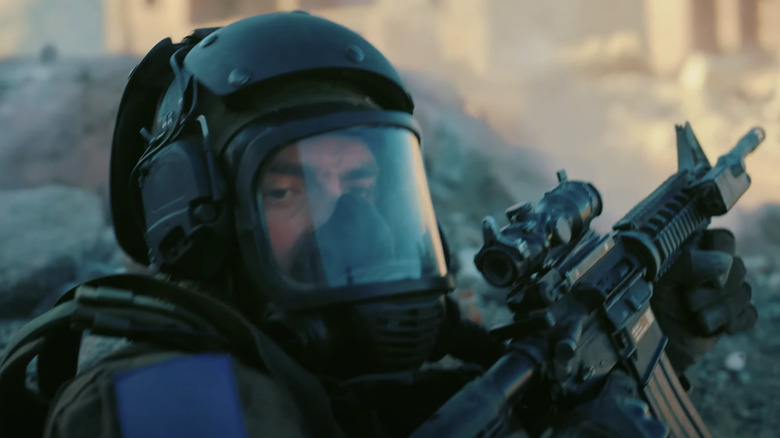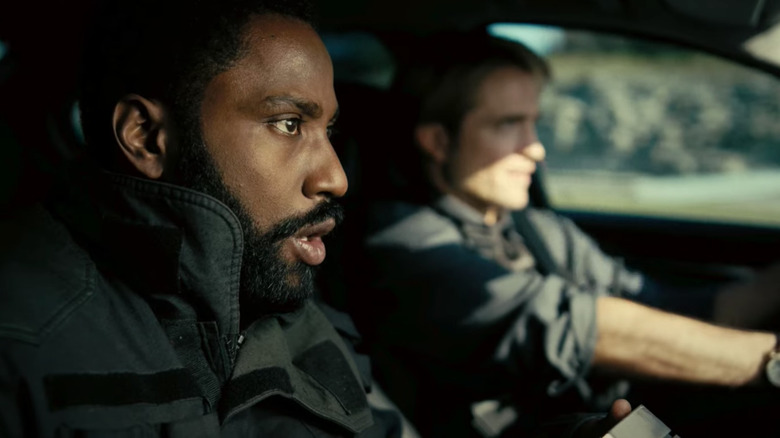Tenet's Most Confusing Moments Explained
Christopher Nolan's "Tenet" offers the type of mind bending, high-octane excitement the director of "The Dark Knight" has become known for — and just as many confusing twists and turns. Starring John David Washington, Robert Pattinson, Elizabeth Debicki, Kenneth Branagh and Aaron Taylor-Johnson, the sci-fi thriller grossed a cool $362 million when it released in 2020 amidst the COVID pandemic and earned mostly positive reviews from critics and audiences alike.
Unfortunately, there were quite a few that didn't understand the complex plot or the purpose of characters such as the Protagonist (Washington) and Kat (Debicki). Indeed, the labyrinth storyline centers around the aforementioned Protagonist and his quest to stop a madman named Sator (Branagh) from destroying the world. Except, Sator is receiving help from people in the future who want to chart a different course in the past to save humanity from destruction.
You see, in the world of "Tenet," time travel exists. People can leap into machines called "Turnstiles" and literally move backwards through time leading to wild sequences involving forward-moving heroes battling inverted villains. Yes, it's all rather confusing, which is probably why one of the characters shrugs off the science and suggests, "Don't try to understand it. Just feel it." That said, we get that many of you may still have questions, and decided to do our best to answer some of the more perplexing aspects of the film. Without further ado, here are "Tenet's" most confusing moments explained.
What's up with the Goya painting?
Early in "Tenet," there's a lot of talk about a Francisco Goya painting. What's the significance of the Goya, you ask? In order to save the world, the Protagonist must somehow get close to Sator. Unfortunately, the man lives his life behind lock and key and doesn't exactly schedule appointments. As such, the Protagonist decides to use the ace up Tenet's proverbial sleeve — Sator's disgruntled wife, Kat.
Kat, we learn, is in hot water for authenticating a forged Goya painting (either by accident or on purpose) given to her by a close acquaintance. Sator, on his wife's word, purchased this painting for a ridiculous amount of money, found out it was fake and decided to use this information to blackmail Kat into staying with him (as all good husbands do). The Protagonist offers to steal the painting for Kat in exchange for a face-to-face meeting with Sator, which leads to the big 747 heist/crash sequence at the Oslo Freeport.
Unfortunately, the Protagonist and Neil (Robert Pattinson) aren't able to locate the Goya during the heist, but decide to tell Kat the painting was destroyed in order to proceed with their mission. Kat later discovers that Sator removed the painting from Oslo on a hunch, or a tip from the future. He literally serves the artwork to his wife on a silver platter as a way to show he knows what she's up to.
What is the Algorithm?
Ah, the Algorithm. Or, the Macguffin of "Tenet" — i.e., the thing everyone is after. Many people die trying to locate all the parts of this device, and we're told it holds the key to our destruction — but what exactly is the Algorithm?
In simple terms, the Algorithm is two things: A) a formula created by a scientist in the future that allows time inversion, and B) a physical doomsday device with enough power to destroy the planet. As explained by Priya, the scientist believed the Algorithm was so dangerous that she created a physical copy that was then dismantled and hidden all over the world — in the past. In "Tenet," we see the race to locate these dismantled pieces. Sator wants to use the device to destroy the world per instructions given to him by a doomed future society that hopes to change the past to prevent their destruction. The Protagonist (and Tenet) want to retrieve the Algorithm to prevent such an event from occurring.
"So while the Algorithm would destroy those of us living in the early 21st century, it would also reverse the entropy of time, from the beginning to the end," explains Den of Geek writer David Crow. "Hence those in the future with the technology to already live in reverse could thus live on in a world where the direction of time, and presumably other laws of physics, have been reversed."
Why did the Protagonist kill Priya?
This one is a little trickier to understand since much of Priya's actions in the film are a little vague. The Protagonist goes to meet the character (played by Dimple Kapadia) at four points in the timeline during which she relays important information to our hero one piece at a time. Ultimately, Priya's (and Tenet's) plan to stop Sator involve allowing the madman to locate and assemble all the pieces to the Algorithm, which is a bold move, to say the least.
Luckily, the gamble pays off, Sator is defeated, and everyone moves on with their lives. Then, during their final meeting, in the film's closing moments, the Protagonist unexpectedly kills Priya in order to keep her from murdering Kat. Priya decides to try and kill Kat "to tie up loose ends," as she is the only character in the film not directly tied to the Tenet organization. Before Priya can pull off the stunt, the Protagonist kills her presumably because he has a soft spot for Kat (and also because her son may actually be Neil) and figures Priya knows a little too much about Tenet.
Things get complicated when you realize the Protagonist likely hired Priya in the past and is actually the one responsible for Tenet — he's not working for her, she's working for him. Priya gets executed by her boss after following his orders. Though, murdering Kat may have been outside of her jurisdiction, so to speak.
How does Neil die?
On first viewing of "Tenet," we completely missed the part when Neil died. To be fair, that final battle is a little difficult to follow. Only on a second (or third) viewing were we entirely clear on what was happening — or so we think. So, how does Neil die exactly?
Well, during that giant action finale at Stalsk-12, the Protagonist makes his way to the hypocenter where Sator's man is busy lowering the Algorithm into a massive hole next to a corpse with a familiar red tag lying on the other side of a locked gate. Sator's man spots the Protagonist and is about to shoot him when the corpse rises, takes the bullet and opens the gate — in reverse. Turns out, this was Neil. Only, we didn't know that at the time because the person was wearing a mask and Christopher Nolan intercuts the action with scenes of Neil driving a jeep outside. What we have are multiple Neils performing multiple actions in multiple directions — some Neils are inverted while others are moving forward. Neil was also the man who saves the Protagonist during the Kiev Opera prologue.
If that weren't enough, Neil reveals that he and the Protagonist have been friends for a long time — in the past. At some point, the Protagonist travels backwards through time, recruits Neil and embarks on a number of grand adventures with the man before he meets his end in "Tenet." Which is sad... we think.
What was the point of the prologue?
As was the case with "The Dark Knight" and "The Dark Knight Rises," Christopher Nolan released the prologue to "Tenet" months before the movie came out. Predictably, the scene drove the hype meter for the director's new film through the roof, but also confused many who weren't quite sure what was happening amidst the intense action. Later, when "Tenet" finally arrived in theaters, the scene made less sense contextually. So, what happened during the Kiev Opera siege?
After watching "Tenet" multiple times, we may have the answer.
Our hero, the Protagonist, arrives at a staged terrorist attack. Sator's crew (disguised as SWAT) are there to retrieve a piece of the Algorithm after which they plan to destroy any evidence of its existence, hence the bombs. Real cops arrive to save the hostages, unaware that Sator's men have infiltrated their SWAT unit. The Protagonist, who infiltrated Sator's fake SWAT unit, thinks he's there to steal parts of a nuclear bomb. After meeting with a mysterious man in a box seat, he learns the location of a "package," rushes downstairs and acquires the Algorithm piece. Except, he doesn't know what it is — yet. Feeling heroic, the Protagonist then goes back inside to help the hostages, gets saved by another masked individual (Neil) and then gets captured and tortured by Tenet (as a test) for his troubles.
How were there two Kats at the end?
At one point during "Tenet," Kat reveals a moment in the past where she witnessed a young woman jumping from her husband's yacht in Vietnam. Since the film deals with time travel, most audience members correctly guess the mysterious woman's identity as some sort of alternate Kat. But how did she get there?
The answer to this question isn't as complicated as others on this list, since Christopher Nolan consistently references this moment throughout the film. We're told that Sator's happiest memory occurred some time ago in Vietnam during which he and Kat enjoyed a relaxing evening together on his yacht. Future Sator ventures back to this time period (while past Sator is at the Kiev Opera, according to Neil) to relive the memory before killing himself and setting off a chain of events that lead to the end of the world.
Luckily, the Protagonist, Neil, and Kat deduce the time and place Sator will make his last stand and send Kat backwards through time (simultaneously healing her inverted bullet wound) to arrive at that same point. So, future Sator is unknowingly speaking with future Kat unaware that past Kat has already taken their son to shore. Past Kat then witnesses future Kat dive off the yacht following Sator's execution at the hands of future Kat. Presumably, past Sator comes back from Kiev and continues on with his life, unaware that his future self just died in the past. Not too complicated, right?
How did Sator not know his plan failed?
Here's a novel question for you: how did Sator not know his plan had failed? After all, he travels back to the past in order to execute his plan, but since he still exists in the future, shouldn't he know his plan to destroy the world failed? This circumstance is what Neil and the Protagonist refer to as "the grandfather paradox," which states that you can't go back in time to kill your grandpa because then the grandpa wouldn't be able to get your grandma pregnant. Thus, you would cease to exist and be unable to go back in time to kill your grandpa in the first place. Paradox.
"Tenet" works around this concept by applying a whole new set of time travel rules. As explained by Esquire, Christopher Nolan utilizes the "bootstrap paradox, or a casual loop" in which an event causes another to occur. In "Tenet," the Protagonist experiences the events of the film, then relays the acquired information to Neil, who travels back in time to affect (but not change) said events with this knowledge.
In another article on The Sign Post, Nic Muranaka and Daryn Steed discuss this idea a little more fully. The pair surmise that the characters are stuck in a time loop with no agency. "Everything is predestined. They did go back in time to stop Sator, so they have to go back in time to stop Sator."
Why was the Protagonist fighting with himself?
During the 747 heist/crash at Oslo Freeport, the Protagonist and Neil come across two doors with a red and blue marker differentiating them. Inside, they happen upon what appears to be the scene of a crime. There are bullet holes in the glass, gun parts scattered on the floor and smoke hanging in the air. Neil asks his partner what happened, prompting the Protagonist to reply, "It hasn't happened yet." Suddenly, a masked man leaps from both Turnstiles and attacks the Protagonist (Neil chases the other), except the mysterious individual is inverted. Meaning, he's moving backwards while the Protagonist moves forward. (To break your mind even more, check out the scene in reverse!)
Later, we discover that the inverted masked man is actually a future version of the Protagonist. He and Neil went back to this moment to use the Turnstile in order to un-invert themselves and return to the normal time flow. See, our heroes inverted themselves in order to save Kat from Sator's gunshot wound following the Tallinn freeway chase. (Plus, they needed to go back to "the 14th" to stop Sator at Stalsk-12.) However, in order to keep from disrupting the past (and since we're dealing with the aforementioned "bootstrap paradox"), the Protagonist has to use the Turnstile without being seen by his past self. He desperately tries to flee his counterpart, but must engage in combat to escape.
Did Neil already know the Protagonist?
Neil and the Protagonist have a long and complicated history. When they first meet up, Neil seems to know a great deal about his "new" partner right down to the type of soda he prefers — Diet Coke. He's also quick to trust the Protagonist despite a relatively brief introductory period. Turns out, the pair have actually worked together for some time, just not in normal terms.
At the end of the film, Neil explains that this moment marks the beginning of their relationship. Except, we know that Neil heads off to certain death (to save his friend) following this exchange. What gives? If one were looking at their relationship from a chronological perspective, the Protagonist we see at the end of the film presumably travels back in time to found Tenet and recruit Neil. Future Protagonist and past Neil then enjoy a series of adventures before the former passes Neil off to his younger self.
This is why Neil was able to save the Protagonist at the Kiev Opera siege and during the Stalsk-12 battle, because he already knew it was going to happen based off information relayed to him by his partner from the future. As explained by Insider, Neil is stuck in a closed loop doomed to repeat the events of "Tenet" over and over again, with each timeline leading to his inevitable death. Or, as Neil states: "What's happened's happened."
Who was fighting who at the end?
In the climactic battle at Stalsk-12, there's a lot of things happening — explosions, gunfire, helicopters, collapsing buildings — much of which is inverted. Visually, Christopher Nolan doesn't do enough to differentiate the good guys from the bad leaving us more confused than elated.
Okay, so after repeat viewings, here's what we know is happening during the grand finale: two private armies in league with Tenet run through separate time periods in an attempt to create a diversion so that the Protagonist, Neil, and Ives can secure the Algorithm. The red team moves normally through time while the blue team waits for the battle to end (right after the big explosion designed to bury the Algorithm), inverts itself and participates in the madness backwards. Both teams unleash some serious firepower and incur plenty of artillery themselves. We see people die, but we don't ever get a good look at the enemy.
The CIA handler at the beginning of the film does admit he's not exactly sure who Sator is hiring to do his bidding. "Private Russians, we think," he says, which makes sense considering Stalsk-12 is part of a collection of closed Russian cities. In the end, all that matters is that Neil and the Protagonist succeed in their mission. Which they do after supposedly slaughtering hundreds of unseen bad guys. Let your imagination fill in the gaps.
What's a temporal pincer?
"Tenet" comes packed with a bunch of scientific jargon that may be too hard to understand on the initial viewing. (Hint: turn on the subtitles.) One such bit of mumbo jumbo involves something called a 'temporal pincer," which is just a fancy way of describing a mission that utilizes inversion. We get a good look at a temporal pincer in the action-packed finale during which two teams tackle the same battle from different directions in time. The red team executes their mission by moving forward, while the blue team waits for the mission to end before inverting and fighting the same battle backwards.
We see smaller temporal pincers occur throughout the film, such as during the freeway chase and the 747 heist. But did you know the entirety of "Tenet" is actually one large temporal pincer operation? We learn as much during the closing scenes where it's revealed the Protagonist is the one behind everything — Tenet, the operation, Neil, etc. After experiencing the events of the film, he goes back in time and sets up much of the film's actions in order to fulfill the time loop. He instructs people to execute specific events, like, for example, Neil saving his past self at the Kiev Opera, and even allows himself to be kidnapped, tortured and recruited by the Tenet organization. He's not altering the past, per se, but executing it the way it's supposed to be executed, as previously established.
